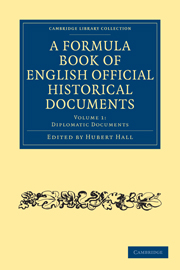Book contents
- Frontmatter
- PREFACE
- Contents
- ABBREVIATIONS USED IN THE REFERENCES, ETC. OF THIS WORK
- I INSTRUMENTS UNDER THE GREAT SEAL
- II INSTRUMENTS UNDER THE SMALLER SEALS
- III DEPARTMENTAL INSTRUMENTS
- IV SEMI-OFFICIAL INSTRUMENTS
- V STATE PAPERS AND DEPARTMENTAL INSTRUMENTS
- 1 ROYAL LETTERS AND OFFICIAL CORRESPONDENCE
- 2 ROYAL AND SECRETARIAL INSTRUMENTS
2 - ROYAL AND SECRETARIAL INSTRUMENTS
Published online by Cambridge University Press: 05 October 2010
- Frontmatter
- PREFACE
- Contents
- ABBREVIATIONS USED IN THE REFERENCES, ETC. OF THIS WORK
- I INSTRUMENTS UNDER THE GREAT SEAL
- II INSTRUMENTS UNDER THE SMALLER SEALS
- III DEPARTMENTAL INSTRUMENTS
- IV SEMI-OFFICIAL INSTRUMENTS
- V STATE PAPERS AND DEPARTMENTAL INSTRUMENTS
- 1 ROYAL LETTERS AND OFFICIAL CORRESPONDENCE
- 2 ROYAL AND SECRETARIAL INSTRUMENTS
Summary
The official correspondence referred to above is best known to us in the shape of originals received by the King or his ministers (In-Letters); but it naturally includes the drafts or copies (Out-Letters) relating to this correspondence or to other business (Nos. 167—171) and from one point of view these Out-Letters are of great importance to us, since the originals are not usually preserved in official custody.
At the same time we shall find side by side with these Out-Letters a large series of ‘Entry Books’ of Warrants, Commissions, Instructions, Passes, Proclamations, Caveats and other Secretarial instruments issued in the King's name (Nos. 172—179) or even on his own authority (Nos. 180—182) by the Secretary of State or some other of the great Household officers whose independent jurisdiction has survived from the mediaeval period (Nos. 195—199). Again, we may easily notice that, for the convenience of the despatch of public business, these instruments are connected with the conduct of Domestic and Foreign affairs respectively by the dual Secretariat of the 17th and 18th centuries. The Warrants and other forms mentioned above belong to the ancient jurisdiction of the Home Department of later times. In addition to this series, however, another will be found in connection with the business of the later Foreign Department, and here we have an interesting sequence of diplomatic instruments (Nos. 183—194) which are still used in principle in our own time.
- Type
- Chapter
- Information
- A Formula Book of English Official Historical Documents , pp. 149 - 163Publisher: Cambridge University PressPrint publication year: 2010First published in: 1908



